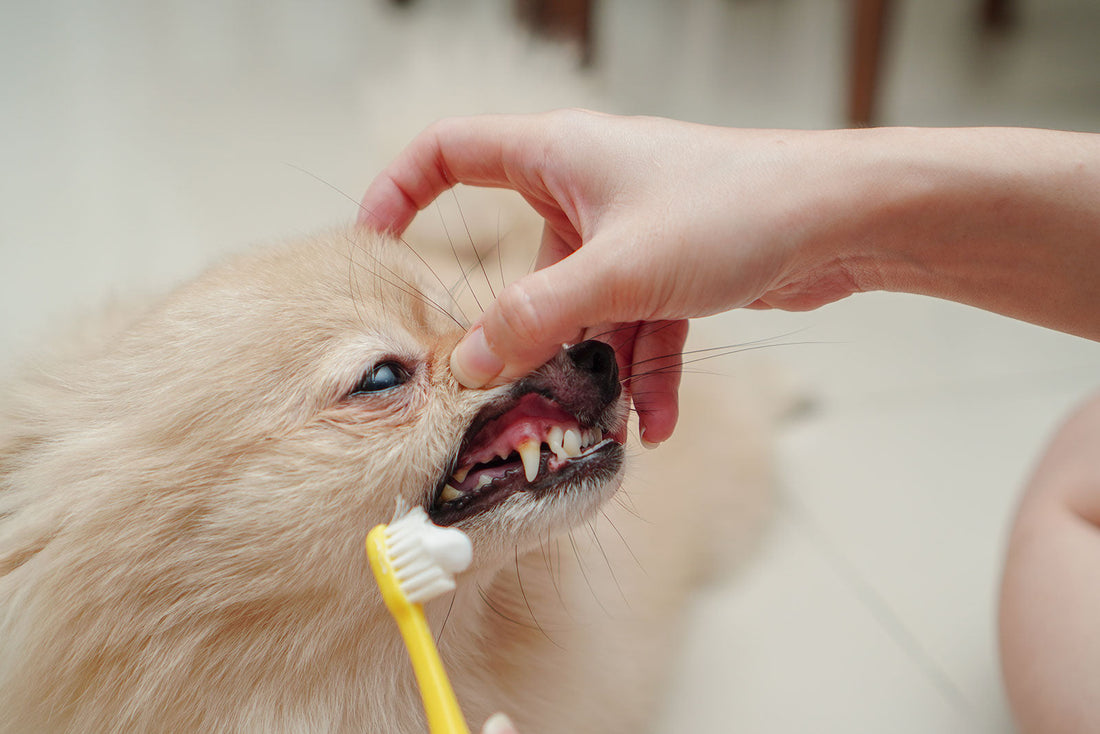Do you notice your furry friend's breath becoming less than fresh? Are their teeth starting to show signs of yellowing or plaque buildup?
Dogs require proper dental care to maintain good oral health. Here's how to remove plaque from your dog's teeth.
Importance of Dental Hygiene in Dogs
Just like humans, dental hygiene in dogs affects their overall health and well-being. Plaque and tartar buildup not only affects the appearance of your dog's teeth but can also lead to serious dental issues such as gum disease and tooth decay.
If left untreated, these dental problems can escalate, causing discomfort and pain for your dog and potentially leading to systemic health issues affecting vital organs.
With regular dental care, you can effectively remove plaque from your dog's teeth, promote healthy gums and teeth, and ensure your furry companion enjoys a happy and comfortable life.
Identifying Signs of Plaque Buildup
Maintaining your dog's dental hygiene is essential for their health and happiness. Keep an eye out for these signs of plaque buildup in your dog's mouth. These serve as early warnings that prompt action is needed to prevent dental problems and maintain your canine companion's vibrant smile.
Bad Breath (Halitosis)
Persistent bad breath in dogs can be a telltale sign of dental problems. Halitosis occurs when bacteria accumulate in the mouth, leading to foul odours. These bacteria thrive on food particles and debris left on the teeth, causing plaque buildup.
If your dog's breath consistently smells unpleasant, you may need to address the underlying cause, which could be dental issues like plaque accumulation.
Visible Tartar
Dental calculus, also known as tartar, is a hardened form of plaque that forms on the teeth over time. It typically appears as yellow or brownish deposits, especially near the gum line.
Tartar buildup not only affects the appearance of your dog's teeth but also contributes to gum disease and tooth decay if left untreated. Regular dental care prevents tartar accumulation and maintains your dog's oral hygiene.
Red or Inflamed Gums
Healthy gums should have a pink colour and firm texture. However, when plaque and tartar accumulate along the gum line, it can lead to inflammation and irritation of the gums. This condition, known as gingivitis, is an early stage of gum disease.
Signs of gingivitis include redness, swelling, and sometimes bleeding along the gum line. Ignoring gingivitis can result in more severe gum disease and potential tooth loss.
Monitor your dog's gum health and seek veterinary care if you notice any abnormalities to prevent further complications.
Difficulty Eating
Dental issues can cause discomfort and pain while eating, leading to changes in your dog's eating habits.
If your dog shows signs of reluctance to eat, avoids chewing on certain toys or treats, or displays sensitivity around the mouth area, it could be indicative of dental problems such as tooth decay or gum disease.
Pay attention to any changes in your dog's behaviour related to eating and consult with your veterinarian if you suspect dental issues.
Guide to Removing Plaque from Dog's Teeth
Maintaining your dog's dental hygiene prevents plaque buildup and ensures their overall health and well-being. Here's a guide to remove plaque from your dog's teeth:
Regular Brushing
Brushing your dog's teeth is one of the most effective ways to remove plaque and prevent tartar buildup. Use a dog-specific toothbrush and toothpaste formulated for pets. Introduce your dog to the brushing process gradually, allowing them to become comfortable with the sensation.
Also, begin with short brushing sessions and slowly increase the duration as your dog gets accustomed to the routine. Aim to brush your dog's teeth at least 2-3 times per week for optimal results.
Dental Chews and Toys
Dental chews and toys are designed to promote chewing behaviour while helping to remove plaque and tartar from your dog's teeth. Look for products specifically labelled as dental chews or toys, as they are often formulated with textures and ingredients that aid in dental health.
When selecting dental chews and toys for your dog, choose options that are appropriate for their size and chewing habits to ensure safety and effectiveness.
Dietary Supplements
Adding dental supplements to your dog's diet can provide additional support for maintaining oral health.
Incorporate products like Poochiful's Plaque Off Powder Remover, which contains seaweed extracts known for their plaque-fighting properties. These supplements are formulated to target plaque and tartar buildup from within, promoting healthier teeth and gums.
Professional Dental Cleanings
Despite regular brushing and dental care at home, some plaque and tartar may still accumulate on your dog's teeth over time. Schedule regular dental cleanings with your veterinarian to remove stubborn plaque and tartar buildup that cannot be addressed through home care alone.
During these cleanings, your veterinarian will perform a thorough examination of your dog's mouth and may recommend additional treatments or interventions as needed to maintain optimal oral health.
Monitor Your Dog's Dental Health Regularly
Paying attention to your dog's oral hygiene and monitoring for any signs of dental issues prevents plaque buildup and addresses potential problems early on. Keep an eye out for signs such as bad breath, visible tartar, red or inflamed gums, and changes in eating habits.
If you notice any abnormalities or concerns, consult with your veterinarian promptly for proper evaluation and treatment.
Remove Plaque from Your Dog's Teeth Today
Plaque and tartar buildup can lead to severe dental issues and even impact systemic health if neglected. Ensuring your dog's dental hygiene is a fundamental aspect of their overall health and happiness.
Invest in your dog's dental care today so they enjoy a happy and comfortable life tomorrow. Remove plaque from your dog's teeth. Shop for dog products today!

